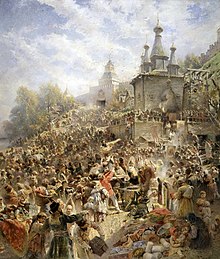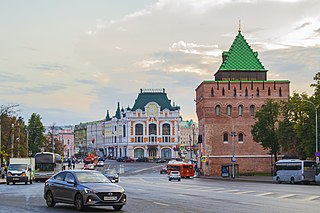
Nizhny Novgorod, colloquially shortened to Nizhny, from the 13th to the 17th century Novgorod of the Lower Land, known from 1932 to 1990 as Gorky, is the administrative centre of Nizhny Novgorod Oblast and the Volga Federal District in Russia. The city is located at the confluence of the Oka and the Volga rivers in Central Russia, with a population of over 1.2 million residents, up to roughly 1.7 million residents in the urban agglomeration. Nizhny Novgorod is the sixth-largest city in Russia, the second-most populous city on the Volga, as well as the Volga Federal District. It is an important economic, transportation, scientific, educational and cultural center in Russia and the vast Volga-Vyatka economic region, and is the main center of river tourism in Russia. In the historic part of the city there are many universities, theaters, museums and churches.

The Monument to Minin and Pozharsky is a bronze statue designed by Ivan Martos and located on the Red Square in Moscow, Russia, in front of Saint Basil's Cathedral. The statue commemorates Prince Dmitry Pozharsky and Kuzma Minin, who gathered an all-Russian volunteer army and expelled the forces of the Polish–Lithuanian Commonwealth under the command of King Sigismund III of Poland from Moscow, thus putting an end to the Time of Troubles in 1612.
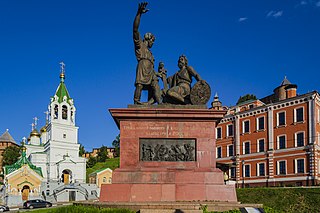
Unity Day is a national holiday in Russia held on 4 November [O.S. 22 October]. It commemorates the popular uprising which expelled Polish–Lithuanian occupation forces from Moscow by a militia from Nizhny Novgorod in November 1612, and more generally the end of the Time of Troubles and turning point of the Polish-Russian War (1605–1618).

Pechersky Ascension Monastery is a monastery in Nizhny Novgorod, Russia. It is the principal monastery of the Nizhny Novgorod Eparchy (diocese) and the seat of the Bishop of Nizhny Novgorod and Arzamas.

The Nizhny Novgorod Kremlin is a fortress (kremlin) in the historic city center of Nizhny Novgorod, Russia.
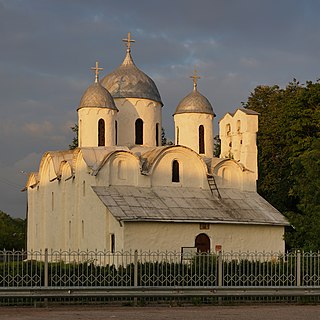
The Convent of Nativity of Saint John the Baptist is a former Russian Orthodox nunnery in Pskov. It is notable for the katholikon, one of Russia's oldest churches, dating from the first half of the 12th century. The church is located at the city center, on the left bank of the Velikaya River, in the Zavelichye quarter. It currently belongs to Krypetsky Monastery. It is the second oldest building in Pskov after the katholikon of the Mirozhsky Monastery and was designated an architectural monument of federal significance (#6010016003). The Cathedral of Ioann Predtecha is part of the Churches of the Pskov School of Architecture, which became an World Heritage Site in 2019.

The Cathedral of the Nativity of the Theotokos is the main church of the city of Rostov-on-Don and the Orthodox Diocese of Rostov and Novocherkassk. It succeeded the Novocherkassk Cathedral as the main place of Christian worship in the Don region.
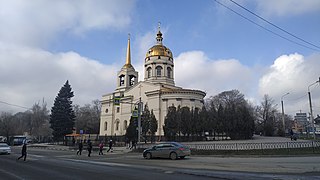
Church of St. John of Kronstadt is an Orthodox church in the city of Rostov-on-Don, Russia. It belongs to Rostov and Novocherkassk Diocese of Moscow Patriarchate. It was built in 2010 on the project of architect Genrikh Vasilyevich Ivanov.

The Alexander Nevsky Cathedral is a Russian Orthodox cathedral church located in the Kanavinsky city district of Nizhny Novgorod. The cathedral is located on the former territory of the Nizhny Novgorod Fair. It is one of the unofficial symbols of Nizhny Novgorod, along with the Dmitrovskaya Tower of the Kremlin, the Chkalov staircase and the fair.

Rozhdestvenskaya Street – an historic street in Nizhny Novgorod. Is a unique open-air museum, there are only stone houses, the history of the oldest of which dates back to the middle of the 18th century. Officially there are 35 monuments of architecture. The most famous landmark is the Church of the Nativity.
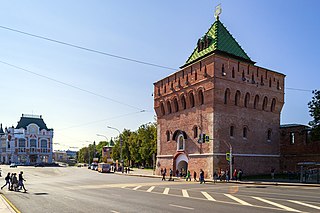
The Minin and Pozharsky Square is the main square of Nizhny Novgorod. It is a social and cultural center of the city, the venue of the most important celebrations. It is located in the historical centre of the old town from the southeast side of the Kremlin.
Orthodox churches in Rostov-on-Don were built during the 17th–20th centuries; they played a decisive role in shaping of the architectural appearance of Rostov-on-Don. They created the high-altitude dominants which were really so important for each city. In addition, all the churches had their own unique style, reflecting the development of Russian art throughout the centuries.

Nizhny Novgorod was founded by Prince Yuri II of Vladimir in 4 February 1221. Citizens organized an army to liberate Moscow from the Poles in 1611, led by Kuzma Minin and Prince Dmitry Pozharsky. During the Russian Empire, in 1817 Nizhny Novgorod became the country's main trading city. In 1896, the city hosted the largest All-Russia exhibition. In the Soviet era, Nizhny Novgorod was renamed Gorky, in honor of the writer Maxim Gorky. Then it was the industrial center of the Soviet Union. During the World War II, the city sent to the front a huge amount of military equipment and ammunition. Therefore, the German air force bombed the city for 3 years. After the dissolution of the Soviet Union, the city was renamed back to Nizhny Novgorod. In Russia, the city became a political center and the capital of the Volga Federal District. Now the city is the center of information technology and develops tourism.

Church of the Assumption of the Blessed Virgin Mary in the Trinity-Lykov is an Orthodox church of the Assumption deanery of the Urban Diocese of Moscow. It was built in the 1840s-1850s in the village of Troitsa-Lykovo near Moscow. The main throne is consecrated in honor of the feast of the Assumption of the Blessed Virgin Mary, lateral chapels - in honor of the Great Martyr Catherine and Nicholas the Wonderworker. The temple is a courtyard of the Intercession Monastery. It has the status of an object of cultural heritage of regional importance.
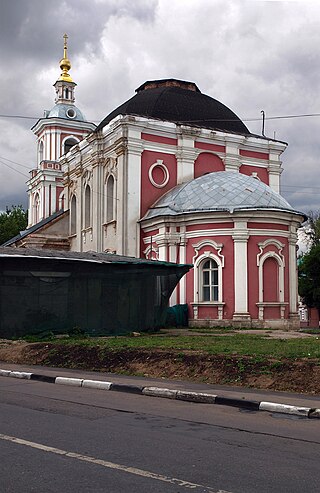
The Church of St. Alexis in Rogozhskaya Sloboda is an orthodox church of the Moscow City diocese. The church was built in 1748-1751 in the Rogozhskaya Sloboda in the style of Elizabethan Baroque. It has the status of an object of cultural heritage of federal significance. It is located at: St. Stanislavsky, Building 29, Building 1. Attached to the church is the St. Sergius of Radonezh in Rogozhskaya Sloboda.

The Church of the Protection of the Holy Virgin on Ostozhenka is church of the Moscow diocese of the Russian Orthodox Old-Rite Church located in Moscow. It was constructed in 1907–08 to a design by Vladimir Adamovich and Vladimir Mayat. In 1932 it was closed as a place of worship, and in 1992 was returned to the Ostozhenka Old Belief community. The building has the status of an object of cultural heritage of regional value.
St. Nicholas Church - is an Orthodox church in Klenovskoye village, Sverdlovsk oblast.

Metropolitan Palladius was bishop of the Russian Orthodox Church; 18 October 1892 until his death he served as Metropolitan of St. Petersburg and Ladoga, the first member of the Most Holy Synod.

The Church of St. Nicholas in Tolmachi is both a Russian Orthodox house church and museum that is part of the State Tretyakov Gallery located in Moscow. The church is home to several religious relics and icons, including the culturally important Our Lady of Vladimir.
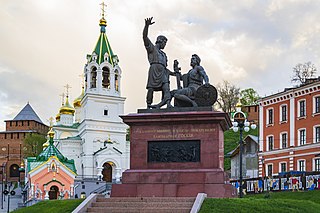
The Monument to Minin and Pozharsky is a copy of the monument erected on Red Square in Moscow. The monument is located in the historic centre of Nizhny Novgorod on National Unity Square, under the walls of the Kremlin, near the Church of St. John the Baptist.


